|
|
FARM 13 / STICK MARSH FISHING REPORTS
BOOKMARK THIS PAGE and come back often to see the latest detailed Stick Marsh fishing reports available.
October 26, 2005
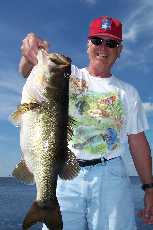
Jay Koeller and his brother-in-law, Chuck came to fish with us on Halloween. I wasn’t sure if that meant the bass might ‘spook’ us, or not. Turns out, we scared a lot of them and hairlipped a big bunch. There were so many 4-6 pound fish, even the witches stopped by to see the guys doing their ‘catching’. It was a fantastic way to end the very productive month of October.
Jay told me he had fished the Stick Marsh a few times with no success and wondered if it really had as many fish as all the stories say it does. He and Chuck are both 100% believers now!!
The water was still filthy from the hurricane and the constant winds. It is the same problem big Lake Okeechobee is having: all the dead grass from last year’s storms is now silt and crud on the bottom; any winds just stir it up and make the water very dirty. We stopped at the pump house in the farm side, where the water was running hard. But, as been the case since 1 October, there were no bass. Also, the dirty water had shut down the nearby crappie hole. So, we headed to the SE spillway.
I positioned the boat parallel to the grass line on the east side and tossed anchors out into the grass for a sure hold. The water was running slowly this day, as the pipes had been turned off and the spillway gate lowered about halfway. But, there was still some current flow around the high spot just off the bank and next to our boat. The key presentation here was to free-line the shiners out past the high spot and its sharp drop-off. They would be pushed downstream slowly by the current, but usually were eaten before they got too far. I gave Chuck the first shiner and turned to rig one for Jay. Before you could say ‘shiner power’, Chuck was fast to a good 6 LB (+) fish. That was largest ever. Handing Jay his rod, I netted Chuck’s bass and took a couple of pictures. Then, before I could get Chuck re-baited, Jay was onto a good bass. It continued like that for the next 4 hours, as bass after bass sucked down the shiners like trick-or-treat candy. For a period, we started to encounter a lot of pickerel bites. So, we moved to the west side. But, the pickerel were twice as thick there and we moved back to our original spot. When we got set back up on the original location, it appeared the pickerel were gone and had been replaced by big bass. So, the party started again. As we got down to the last shiner, I started to rig some dead ones from the livewell.
GOOD FISHING TIP: A dead shiner will often still catch bass if you rig it properly. Here’s how. Hook the shiner in the high part of the back, just at the front of the back fin. This makes him hang in a fairly level and upright position. It looks pretty normal. Any wind or water current action will make the shiner move sufficiently to appear alive.
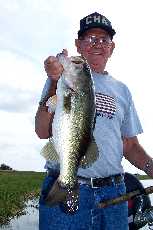 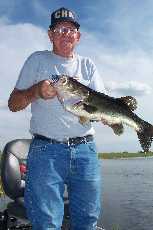 We caught our final three bass on two dead shiners and the last live one. Jay had the live shiner out under a bobber and got what was probably his largest of the day (plus, it was his largest bass ever, too). Sometimes, it is better to be lucky than good!! A great day with two fine gentlemen.
We caught our final three bass on two dead shiners and the last live one. Jay had the live shiner out under a bobber and got what was probably his largest of the day (plus, it was his largest bass ever, too). Sometimes, it is better to be lucky than good!! A great day with two fine gentlemen.
October 29, 2005
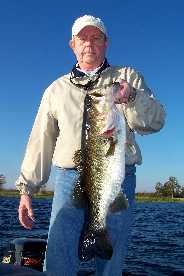
Richard Rasey made the trip down from Jacksonville to fish the Stick Marsh for 3 days. He planned to do a half-day with us and then fish the other 2 on his own. His support situation was good, in that his daughter lives in Palm Bay and was gone for awhile. That gave Richard fine accommodations in a nice, nearby apartment.
The very dirty water from the winds of the hurricane, plus the high wind conditions of the fishing day, told us we needed to head south to the Farm 13 spillway. Arriving in the spillway basin, we noted 3 other boats fishing the fast current flow coming from the spillway. One of the three pipes on the east side of the basin was also open and running. There was a lot of grass and debris coming out of the spillway, but the water was fairly clear. Of the folks fishing close to the spillway, I don’t believe we saw more than a half dozen fish caught among them.
We set ourselves up on the east side on the basin and fed shiners out into a current eddy. This particular location was one of my favorites when the water flow had lots of trash in it, as the trash did not come too far back into the eddy zone. Boy, did Richard catch those bass! A lot of them were 5(+) fish, too. Really nice, heavy fish. The largest may have made 7 lbs. On moving water conditions, bass are always staging for a meal and today was no exception. While Richard burned up the bass on the live bait, I rigged a 4-inch JuneBug RIPPIN’ Stick on a Carolina Rig. After a few casts, I located a hard, rough spot behind the boat and started to get small 2-lb. fish about every third cast. That was a good sign, in that we would be able to continue to catch bass after the shiners were gone.
After the last shiner had gone to baitfish heaven, I gave Richard a C-rigged rod and a handful of RIPPIN’ Sticks and then pulled the anchors. For the next couple of hours, we did something I had found would work the day before. We moved all around the open water of the spillway basin, anchoring at times and working the Carolina Rig briskly across the bottom. While the loose grass would foul us occasionally, we still caught a LOT of bass. And, we would catch them just about anywhere we cast. The entire basin seemed to be filled with them. The most productive locations, however, always seemed to be right where the main current and the eddy flow would run against one another. A really good benefit of fishing this way was that we got away from the pickerel.
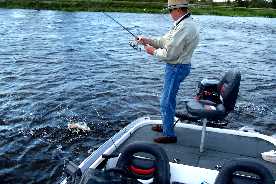 Richard fished the next two days from his NITRO rig and did well. In fact, the next day he caught a half dozen giant bass, with one weighing in at 13 lbs. That’s a trophy in anyone’s fishing hole, anywhere!
Richard fished the next two days from his NITRO rig and did well. In fact, the next day he caught a half dozen giant bass, with one weighing in at 13 lbs. That’s a trophy in anyone’s fishing hole, anywhere!
October 26, 2005
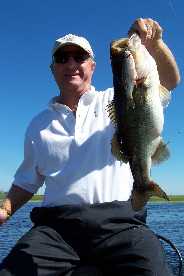
Lee Tuttle called and stated that he want to try for both bass and crappie. I explained that the water was in pretty poor condition from the hurricane winds and that I was not sure how well we would do. Finally, we decided to try it out and, if it was not fishable, Lee and his partner, Tommy Hooks, would just pay our gasoline expenses and come back another day. It turned out to be an excellent day for bass and a poor day for crappie. The main water was really bad, with a lot of color and a lot of suspended silt. That made the crappie a mute point.
But, checking the SE spillway of the Farm 13 side found us some decent water, although it was flowing very hard and with a lot of trash in it. We started out in an eddy section on the east side and found plenty of bass. Both anglers caught really big fish. Moving to the west side, we set up on the old submerged barge. A few good fish came to the shiners, but there were just too many pickerel for my liking. Shiners are too costly to feed to Mr. Toothy. So, we re-positioned the boat a bit south and right along the west shoreline, just north of the warning sign. The fast-moving water was just too trashy with grass and other debris to put the shiners out into the flow, so we fished close to the west shore grass off both the front and back of the big Blazer. This appeared to be a charmed spot for Tommy Hooks, as he banged 5-lb (+) bass at will all along the grass and got an occasional giant.. He would get Lee to fish his hotspot, but Lee’s shiner seemed jinxed and just swam around. But, when Tommy tossed his back in there, it lasted on a few seconds. Fishing is sometimes strange. However, Lee gradually got his shiners in gear and started to match Tommy fish for fish. In fact, he got a giant that may have been the big bass of the day. It was close. Really superb fishing under what were tough conditions, unless you knew how and where to adapt.
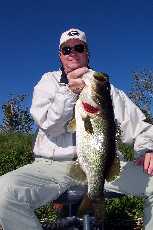 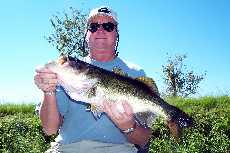
October 21, 2005
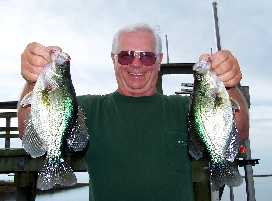
While waiting for hurricane Wilma to decide whether she is going east/west/north/south (or all four!), we are staying right in there with the fishing. The stray bands of showers and storms reach out a long way from Cancun and today was no exception. Here we are approximately 650-700 miles away from Wilma and she dumps 3 inches of rain on some parts of our area. My drain port from the big Blazer boat floor to the bilge was apparent obstructed for a while. In 30 minutes, I had ankle-deep water in the rig. That’s a LOT of rain in a short period. But, the fish did not seem to care at all. Read on!
Harry and Shirley Chrzanowski are new friends of ours from the North Carolina mountains. Being a Buffalo, NY, native, Harry had never caught big largemouths, and the crappie in his home area were somewhat small, too, he noted. So, Harry wanted a fish trip to the famous Stick Marsh to see if all the stories he had heard had any truth in them. I think he is now convinced!! As I recall, his words were: “More fish than I have ever caught in a day; in fact, in three days added together!” / “Are they always this big?” / “I didn’t think you could catch a big crappie every cast; but, now I have seen and done it.” / “ How many did we catch? I lost count a long time ago.” / “Those big bass really blow up on those shiners. That’s awesome.” / “When is your next open day. I gotta do THIS again and SOON!!”
I have to admit that it was an exciting day on the water. And, everything Harry had been told about the Stick Marsh came to pass.
Our first stop was a shellbed located near a pump station. The first cast, and nearly every following cast for 20 minutes, produced a slab crappie. All he had to do was try to get a chartreuse, w/blue tail PERFECT Jig to the bottom in 14 feet of water. About half never made the complete drop down to the shellbed. You could sit and watch the line twitch as the papermouths inhaled it on the way by. When the jig did make it fully down, a quick wrist snap to get it off the bottom, followed by a very ‘slowwwwww and steadddyyyyy retrieve, nearly always accounted for another slab. Crappie fishing at its absolute best!
From there, we moved a couple of hundred yards to a shellbed on top of a submerged levee. The high winds were creating a lot of induced water current along the adjacent submerged canal and, when the winds are from the southeast and this current flow is heavy enough, the bass nearly always come to this particular shellbed to feed on the moving water. There were sure there this time, too. One of Harry’s questions had been what a Carolina Rig was and how it was fished. He got it answered fully. JuneBug and Green Pumpkin 4-inch RIPPIN’ Sticks, with a ¼-oz. Sinker did a great job.
From there, we made our way to the south end of farm 13 and one of the submerged canals that is lined with stumps and logs. Wanting to sample all facets of the bass fishing available in the Stick Marsh, Harry had sprung for a few dozen shiners. The first order of business was to get the sea anchor in the water to counter the 15-20 MPH winds. Then, I put two lively baitfish to drift out behind the boat, while Harry and I explored for fish with the 5.5-inch RIPPIN’ Sticks. One of the shiners was hardly even wet yet, when an old sow bass blasted the hapless baitfish four times in rapid succession and, then, took off with it. There was little need to set the hook on this bass, as she hit the end of the slack at full speed just about the time Harry got the clicker off and the reel gears engaged. We stayed there for a good while, listening to clickers whine and fish blow up on our shiners.
As storms went past all around us, the winds started to get higher and higher. Then, the rains started to get heavier and heavier. We decided to leave our present ‘honey hole’ and take a bit of shelter over in the spillway basin in the southeast corner of the Farm. To our delight, we found the water running strongly from the spillway. To our dismay, we found the moving water to be chock full of grass and trash. You couldn’t get a line through the mess to fish. But, we found a way to work this problem and it turned a LOT of bass for us in the next two hours.
We moved around within the basin working the floating grass masses as they gathered in the various eddies of he main current flow. Most of these were on the east side of the basin and maybe ½ way to the north entrance point. Once the floating grass slipped into an eddy zone and slowed significantly, we found bass to be all around and under these grass accumulations. Harry actually found the bass in these type locations as he tossed the RIPPIN’ Stick around the grass and let it drop on a slack line. In the meanwhile, I was busy working the RIPPIN’ Stick with a fast, erratic retrieve around the mats. I got the topwater presentation hit very hard a lot, which was really exciting. But, they were all big chain pickerel. None of the bass tried for the lure in the surface mode. Meanwhile, Harry was doing a number on the fish with his slow presentation. We spent an hour fishing in this manner and gradually found ourselves back around at the spillway.
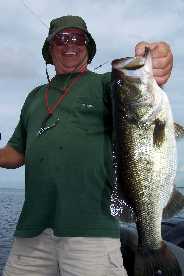 Well, guess what?! The grass had cleared a great deal and the water was now running pretty clean. That was sure a quick change of pace. Setting up near the single piling in front of the spillway, we found Carolina rigged jerk baits good producers. About 50% of the casts got fouled with grass, but the other 50% usually got fouled by bass! Noting we still had possibly a dozen shiners left, we moved into an eddy just off the strong current flow and set up for some free lining. Again, half the time we got grassed over, while the other half would be a quick ‘take’ by some very strong 3-5-lb. fish.
Well, guess what?! The grass had cleared a great deal and the water was now running pretty clean. That was sure a quick change of pace. Setting up near the single piling in front of the spillway, we found Carolina rigged jerk baits good producers. About 50% of the casts got fouled with grass, but the other 50% usually got fouled by bass! Noting we still had possibly a dozen shiners left, we moved into an eddy just off the strong current flow and set up for some free lining. Again, half the time we got grassed over, while the other half would be a quick ‘take’ by some very strong 3-5-lb. fish.
Harry Chrzanowski is now a ‘Stick Marsh Believer’. As soon as he gets out of his state of shock, he plans to come directly back for a second round!!
October 19, 2005
Brad Long called me at 11:30 PM on Tuesday, 18 October. He allowed that it was sort of a ‘short notice’ phone call, but could I take him out to the Stick Marsh the next day. He had a half-day open after a morning business meeting in Palm Bay on Wednesday and had delayed his flight back to St. Louis until Thursday. It sure sounded like he was plotting conducting business around a fishing excursion. My kinda guy!! How could I not say ‘yes’. Besides, it was a fine excuse for me to get to the pond, as well!!
This was one of those afternoons that happen once in awhile. I think the last day to match it was 25 April 2005. When Frank Simmons and I sat in one place, on one shellbed, while Frank caught some many bass that it was hard to maintain count. I estimated he 100, or better. But, the real kicker was that close to 1/3rd of Frank’s bass weighed between 5 and 8 pounds. Talk about a guy having a tired back and a sore arm, that fisherman had both!!
In Brad Long’s case, the winds were different and more from the east. That pushed the water to the west and caused it to seek its own level by back-flowing back to the east in the submerged canal that runs east-west across the center of Farm 13. While the winds pushed the surface waters to the west, the water down in the canal depths was actually flowing back east. We have seen this phenomenon create whirlpools at certain canal intersections when the winds are exceptionally high for a number of days in a row and multiple reverse currents collide. I really had not anticipated this reverse current situation when I set the anchors down on this particular location. My intent was to anchor in the center of the submerged canal so that the two anchors I had out would catch on the inside of the canal trace and hold in the strong winds. While Brad unsuccessfully worked the submerged levees with a heavy Carolina Rig, I happened to see baitfish skitter across the surface just a short distance down the canal from us. Then, a single bass came up on a hapless baitfish with a loud bang. Then, a half dozen hungry bass exploded out of the water after the bait. It took less than two minutes to haul the anchors and re-position the boat 30 yards further down the canal!!
For the next 4-1/2 hours, Brad had an absolute ball catch fish after fish. I doubt any of the fish went over four pounds, but NONE were less than three pounds, either. It was pure gluttony in catching fish. Everyone should get so lucky as to do it at least once in his fishing adventures. When we finally got ready to head in, I told Brad I wanted to loop around the location of this marvelous school of fish to see if I could identify what was holding them in that particular spot. It turned out that the location was maybe 50 feet north of the intersection of the middle north-south Farm 13 canal and the single east-west canal. I had not realized we were that close to the intersection. But, the current flows in and around the intersections were probably why the bass were there (that and the baitfish feeding on that current flow).
My apologies to Brad and to you, the reader. I did not charge the camera battery for nearly two weeks and it just gave up the ghost on me. Possibly, when Brad gets his film pics back, we can run a few of them.
October 14, 2005
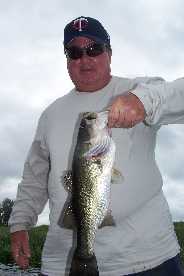
This time, we hosted brothers Bob and ‘Kit’ Carson from over Sarasota way. Really great people to share a boat with. Even if it did rain like the dickens and the wind blew 20-30 MPH from the north all day, we still had fun. Our saving grace was that it was warm air and warm rain and not enough to chill us. So, wet feet and all, we fished the entire day. We started over on the north wall of the Stick Marsh, just off the palm tree line, hoping for some protection from the wind. After just one lone bass of JuneBug RIPPIN’ Stick, we decided to make the rough run to the SE spillway of Farm 13 in hopes of a windbreak there. As we passed the pump on the east wall of the farm, it was just our luck for it to be running full bore. But, it also had three-foot waves crashing into the pilings, so we kept on for the SE basin. We noted three boats headed in from the south end of the farm at that time. I expect they had decided that the waves and wind might well lift their boat and set in down on a hull-crushing stump if they delayed longer. I expected to find some boat in that basin, but none were present. The wind was also barreling right down the basin and the only partial windbreak was right against the west side grass, near the submerged barge. We actually set our two anchors out upwind of the barge, so they would catch it and hold us. Then, we floated shiners to the grass line and over the barge. We got a few takers, so it stayed interesting. A bit later, we moved further down towards the gate and set up on the west side just above the yellow warning sign. The shiners floated downwind towards the drop-off just past the sign and the piling just to its left. Again, just enough fish to keep us fishing hard. As the afternoon passed, the winds shifted slightly to the NE and actually slacked off to a mild roar. Taking advantage of the new situation and more ease in anchoring, we again re-positioned the boat. This time, we set up where we could free-line the shiners into the deep hole in front of the spillway. This worked fairly well and gave up a number of bass, plus one big old catfish. Kit decided one of his bass was a 'Hollywood' show-off for all the jumping it did. So, the angler gave the fish an appropriate Tinsel-Town look with his sunglasses!! For your information, the chain pickerel are still around in there, too. They also still like shiners. The Carson brothers had no big bass in the bunch. But, considering the really miserable fishing conditions, their perseverance paid off with probably the best catch on the impoundment that day.
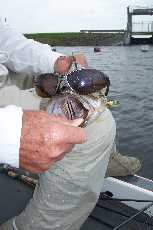 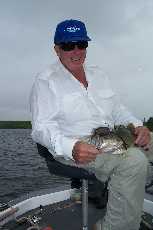
October 11, 2005
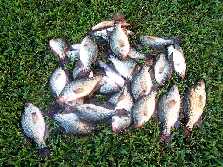
Tony Vail was visiting his parents in Titusville and some told him we guided for crappie, as well as bass. Tony figured he could get a guide trip, plus provide enough crappie for a neighborhood fish-fry. He wasn’t disappointed, either. Since we had been doing well on the PERFECT Jig, I suggested we simply use the artificial lures and save the cost of live minnows. Plus, I assured Tony that I put 50 fresh fillets in my freezer just a few days earlier and would take care of him for the fish-fry, if the fish got lockjaw. We sure got lucky, in that Tony got a limit (25 crappie) in an hour, or so. We left this location and went to the SE corner of Farm 13 in hopes of finding even larger fish in the spillway basin. There were lots of small fish, but none better than what we already had. So, we went back to the 'honey hole’ and anchored, catching fish and culling for the rest of the afternoon. But, the next day, as well as the past 5 days, the crappie simply disappeared from the screen. Maybe we pressured them too hard. I do know another angler and his wife saw me work on these crappie at this specific location right after I got back from North Carolina. He, then, appeared to be fishing on them nearly every day. I suspect they have just opted for survival and begun to avoid the location where we have targeted them.
October 10, 2005
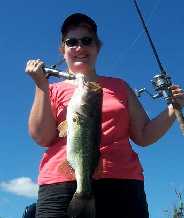
We started out with Chad and Billie Benson. They wanted bass, but had never fished for them before. So, I recommended a mix of shiners and artificials. The weather really wasn’t too bad, except it was HOT. I acclimated the shiners (see the ‘TIP’ below) for an hour prior to meeting the Benson’s at noon and off we went to Farm 13. I had spent a couple of days the week before working the farm to find fish, so I knew I would probably do best on the south end of the north/south canal at coordinates F, 2-3. All those stumps and old trees underwater along that submerged and its levees always have some fish. I had rigged up two unweighted RIPPIN’ Sticks for the pair to use while I put two shiner rods out to drift behind the boat (when drifting shiners, always use no weight and set a bobber about six feet up the line; do NOT set the hook unless the bobber is out of sight for five seconds, or more). Immediately, a bass blew up one of the shiners. Then, the fish hit it again 3 times. Finally, on the fifth swipe, the bobber went away and stayed down. Billie brought in a good four-pound fish. Then, we went dry for an hour. The next action started when Billie had a good boil on her RIPPIN’ Stick just as it hit the water. This time, it was five pounds. Chad was getting anxious!! A few minutes later, he got a small bass on the jerk bait and, soon, he played in a solid three-pound fish on a shiner rod. It sorta went like that all afternoon, with only 18 fish to show for six hours on the water. Billie’s five pounder wound up as the top fish.
October 8, 2005
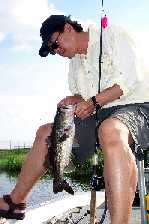
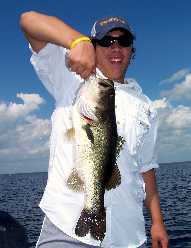
This day, we had Phillip and David Nakano, a Father and son team out of Georgia. I thought fishing was tough with the Bensons, but we really had to scratch for them with Phil and David. The same submerged canal yielded a few fish, with a five-plus being the best. Then, we decided to leave the wind and waves and go to the southeast gate basin. The water was running hard, but it was very dirty and full of grass fragments. To be able to get away from the line-fouling grass, we moved into an eddy zone on the west side. We had to re-set the boat a few times to get properly positioned, but finally made it work. There were no fish gathered in the moving water and the ones we managed to get were just stragglers – one every now and then. We quickly learned that free-lined shiners would immediately get hung up in the debris and old lines on the bottom where we were positioned. So, we changed to bobbers and set the shiners at five feet. That allowed us to catch a decent number. Although the total quantity was not large, all the fish the Nakanos caught were good, above-average fish. That helped a lot.
FISHING TIP: The present water temperature at the Stick Marsh has been 84-88 up in the day, and not below 80 at daylight. Shiners do not tolerate heat well and die easily. Here is what I do to lessen their mortality rate. It really has worked well these past few days. First, leave the shiners in the oxygenated bag they provide at the baitshop. As soon as you get to the Stick marsh, put the unopened bag(s) in the livewell(s) and pump lake water into the well(s). Do this for 30-60 minutes BEFORE opening the bag and dumping the bait into the well(s). This will allow the baitshop water (usually around 55-58 degrees) to warm up gradually and start to reach the temperature of the lake water. This prevents a sudden temperature shock to the shiners. It works. DO NOT attempt to add ice to the live well waters to cool it down. The water the ice is made from almost always contains chlorine, which is deadly to the shiners. Plus, taking those shiners from cool water and tossing them into the warm lake water will surely cause a sudden temperature shock.
Our present advice to you is to wait a bit before traveling any long distance to fish the Stick Marsh. It appears to be in some sort of transition now and fishing can be spotty. During the past two weeks, we have found the bass on the submerged levees, in the canals, along the southern farm 13 canals and wooded areas, along the west wall of the Farm, and even over in the Stick marsh, itself. Some were good-sized, but hey were not in quantities expected. The biggest surprise has been that there have been very, very few on any of the moving water location. However, the concentrations are not large and you really have to work at it to catch a decent string. Those we have caught at the pumphouse and the SE Farm spillway have nearly ALL been when the water flow was SHUT OFF! That really an odd situation. The impoundment will get a lot better than this as the weather cools and the effects of all this fresh rainwater wears off. Then, we’ll be telling you when it gets back up to speed and how to catch them!
6 October, 2005
RETURN TO THE STICK MARSH
Well, we got back to Florida from our North Carolina roost this past Sunday. Sure enough, there was tropical storm Tammy out in the Atlantic just waiting to form up. However, this time we were lucky and she just went up the coast. A bit of rain, some strong winds and she left for Georgia.
Monday was unpacking day. Tuesday, I went to the Stick Marsh amid rain and 40 MPH winds. Heck, I figured I owe it to my clients this next Saturday and Sunday. I really needed to get back on some fish. Besides, I can usually handle the strong easterly winds with that big Blazer boat. Plus, I have a couple of good places that are shielded from those winds well. The bass didn’t happen, though. I just could not position and hold the boat in the proper place. I did manage six on a heavy Carolina Rig before I gave up. So, I know they are on that particular shell bed. I moved further back towards the east shoreline of the Farm until I managed to get two big anchors to finally catch and stop the boat, giving me a chance to work just the general area along a submerged levee. Again, no bass. BUT, there was the biggest school of slab crappie you’ll ever see!! Every cast with the chartreuse/blue tail PERFECT jig got one. They were holding in the canal, itself and down near the bottom. I suppose they were getting away from the turbulent waters above caused by the strong winds. Who knows for sure, but it was fun and sure made good eating that night!
Tuesday night, the storm moved up the coast to the Daytona area, leaving the Stick Marsh with 15-MPH southerly winds and just a scattering of small showers. So, as any concerned guide (who is not on the bass well and has near-term clients due in) would do, I headed back to the pond on Wednesday afternoon. I did not try to catch every bass in the place. But, instead, I would always move if I caught two or three quickly and predictably. Here is what I found.
I started on the east-west canal that runs across the middle of Farm 13. Two intersections yielded one mudfish. Finally, the third shell bed on the submerged northside levee had what appeared to be a school. Three casts with the C-Rig produced two bass around three pounds and a missed hookset.
Moving to the sound end of the farm, I started out on the east side and worked all the previously productive areas all the way to the Nursery on the west side. I was able to get fish from each area I addressed, but only one gave me the three I was looking for. All gave up at least one. My interpretation of what I found is that there are few fish in the very shallow section of the south wall of Farm 13. The majority (at least from the strikes I got) appears to be well out to the north, away from that south shoreline a good 300-500 yards. I used a spinnerbait, a weightless 5.5-inch JuneBug RIPPIN’ Stick, and my ‘little green plug’ (the FireTiger, 1/3rd oz. Big O). The spinnerbait zeroed. The jerk bait caught 4, while fishing it with a slow ‘pull-drop-pull-drop’ retrieve. One bass took it as it hit the water. I could not draw any topwater strikes, save for little Needlefish. The Big O, however, took up where it left off back at the start of the summer and garnered eight bass, from 10 oz. To 7 lbs. That says a Rat-L-Trap may also work well.
The grass that was ripped out of the Farm 13 and Stick Marsh sections by the 2004 hurricanes is, as predicted, starting to grow back. It is not growing as fast as I would have thought, but it is starting in a number of locations. I found some decent clumps a foot high in the NE section of the farm. More was found in the south-central section, a long way out from the south shore. A really nice thing found was that all the shell beds appear to have grass started on them. That makes the shells easier to find. Rather than relying on the C-Rig sinker to locate the hard shell bottom, we can look for short grass growth with the depthfinder.
‘FISHY SMARTS’ LESSON OF THE DAY: The submerged levees of the Farm 13 side lay out in the sun for years while the area was an active farm. That made them like baked concrete. Grass has a tough time rooting itself in that type hard bottom. However, once rooted, the yearly cycle of grass die-off and decay generates a soft base for the next crop to take root in. Likewise, the old fields were plowed and planted again and again, keeping that soil fairly loose and preventing hardening like the levees. Grass takes root in the field location easily. Shellbed colonies are always positioned on high ground, such as the submerged levees of the Farm. That is so the water currents will keep the slit washed off and prevent it covering the beds and suffocation the shells. But, some silt (dirt) does manage to get down with the shells and under them through the settling process. That bit of soft dirt provides a fine base for the milfoil and hydrilla grasses to root in. That is why I think the grass is coming back better on the shellbed areas and softer field sections of the Farm, rather than along the levees. I believe the grass will be slow to come back along the levees, themselves, but will show up more strongly on shellbeds and in the old planting locations.
We will keep looking for more ways to address the bass until we are sure it is right. Plus, if you like to do lots of crappie, I think I have some good places.

Today's Weather for
the Stick Marsh Area
Past Stick Marsh Fishing Reports
Farm 13 / Stick Marsh Information Guide
Email questions to jporter@jimporter.org.
|
Recommended sites by The Fishin' Tipster |
A common question that we get: "Is there somewhere close to get bait and tackle?" This is where we get our bait.

Pete and Tina Heinz / 9 South Mulberry St. / Fellsmere, FL 32948 / 772-571-9855
Get your site listed here
Let us help you drive more targeted traffic to your site.
|


Rank our Site
©Copyright 2001-07 All rights reserved by Jim Porter, any reproduction, quotation or other use of this site or its elements is prohibited without the express written permission of Jim Porter
|
|


 FROGG TOGGS RAIN GEAR
FROGG TOGGS RAIN GEAR
THE BEST PRICES AVAILABLE!!


|
|







